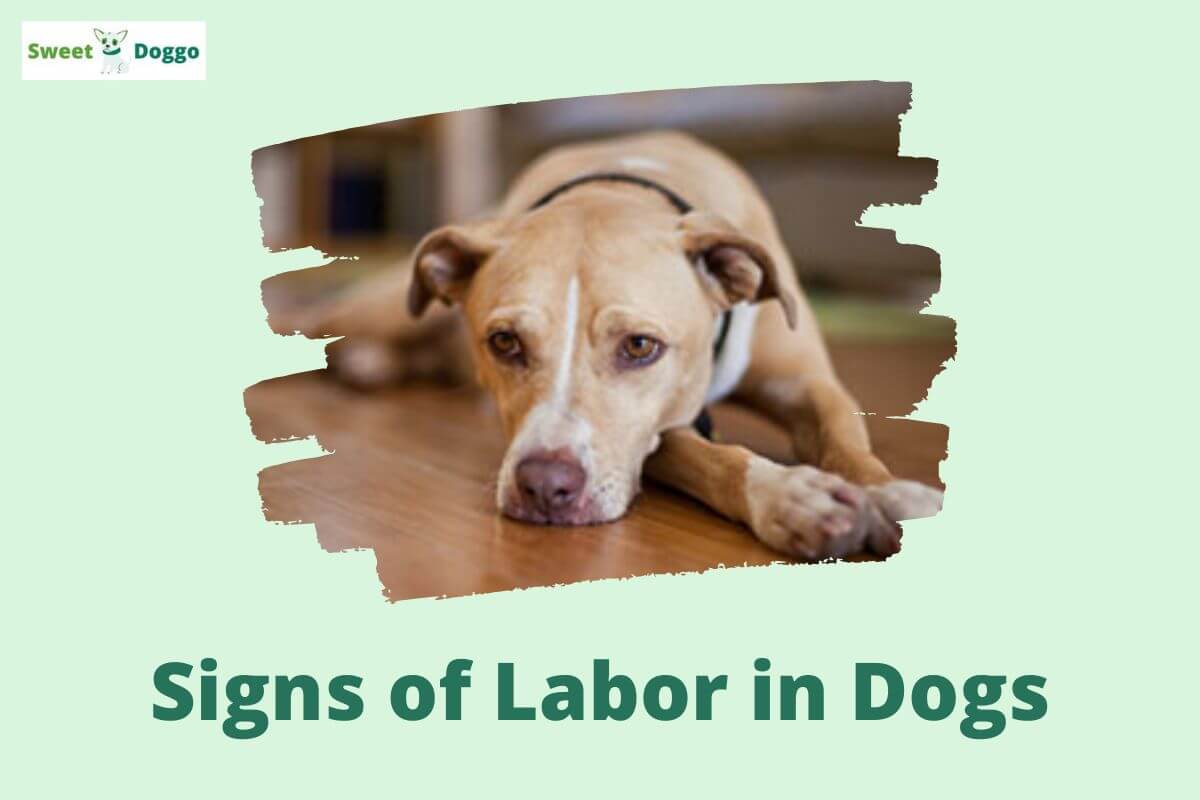As an owner, you probably already know your pregnant dog’s due date. However, it is also recommended to learn to recognize the signs a dog is going into labor soon. You will always be able to better assist your pet if you know how to identify when labor has started.
This is especially important if it is a first-time dog.
Keep reading below to find out the possible symptoms of labor in dogs and when they usually appear, and what you can do to manage them.
Table of Contents
Signs a dog is going into labor soon
Once the time is right, the pregnant dog shows key signs that herald the start of the different stages in the birthing process. We could think of these symptoms as a ladder since they usually appear in a set order; the presence of a new signal marks the ascent to another rung.
Note. Keep in mind that not all dogs are the same, nor do they have exactly the same signs in the same order.
Typically, these are the 12 common symptoms that appear when a female dog is going to have her puppies:
1. Drop in body temperature
As experts explain, this is one of the most reliable labor symptoms. A dog’s normal temperature is usually 101 degrees Fahrenheit or 38 degrees Celsius. But just before delivery, the body temperature drops to about 97°F (36°C) and stays that way for a while.
Obtaining 2 consecutive low readings, taken 12 hours apart, indicates that the dog is going into labor, usually within 24 hours.
That is why it is advised to keep a daily chart of the pet’s rectal temperature in its last week of pregnancy. This can certainly help determine when delivery is coming.
If a female dog shows no signs of labor after 1 day of temperature drop, it is best to consult the vet.
2. Nesting behavior
This is a natural behavior in the vast majority of dogs. The future mother will try to find a den or hiding place where she feels safe and comfortable giving birth to her pups; for example under the bed, in the bathroom, etc. In general, it is an indication that the dog is going into labor.
Some bitches start looking for their nest about 1 week before their due date, but it is usually more noticeable behavior just the day before.
To help her, be sure to prepare a clean and safe cardboard box that she can easily access. A good birthing box should offer some privacy, be large and comfortable enough, not have too low sides, and be lined with newspapers, towels, and blankets.
3. Anxiety, nervousness, restlessness
Anxiety about the impending birth can give the dog a worried, tearful, and even frowning appearance. It is normal for her to want to stay close to her owner.
Also, she can look nervous and agitated at all times. Typically, a female dog about to give birth will not want to be around other pets or strangers. This is a clear sign that dog is going into labor soon.
4. Tiredness and lethargy
Some pregnant females are known to spend a lot of time resting before giving birth, especially in the last few days. If the due date is very close and the pet seems increasingly lethargic, then the puppies may be due.
5. Greater attachment to its owner
Expect the pet to follow you wherever you go. It can even stay next to your bed, or under it, while you sleep. The arrival of labor makes her want to be close to the person she trusts the most.
6. Loss of appetite and vomiting
On the other hand, it is common for the pregnant dog to stop eating 1 or 2 days before going into labor. In case she does eat during this time, she considers that she may vomit. She is also likely to have a large bowel movement within 24 hours of birth, which occurs as a result of pressure from the pups.
Both vomiting and bowel movement are signs of what your body is about to experience. Make sure to provide fresh water at all times.
7. Panting
Does the dog pant while resting? That’s an almost sure sign of labor in dogs. It is common for her to pant rapidly for a period of time; then she may pause momentarily before resuming the behavior.
8. Open nipples and possible excretion of breast milk
While not all pregnant dogs do, some may expel milk before giving birth. In that case, the owner can observe small leaks, in addition to enlarged nipples and swollen breasts.
9. Licking of the genital area
The frequent and insistent licking of the genital area by the bitch is a strong indicator that she is preparing to have her young. In addition to cleaning the area and surroundings, this is believed to help ease the aches and pains associated with childbirth.
10. Expulsion of the mucous plug
Several hours before delivery, leakage of the mucous plug in the form of a yellowish vaginal discharge may occur. This mucus has provided protection to the uterus and the developing puppies throughout the gestation process.
11. Tremors and contractions
As expected, the first contractions are clear signs of labor in dogs. At this point, the dog may experience chills that are accompanied by periodic undulations in the abdomen.
Once those symptoms appear, gently place your hands on either side of her belly. The abdomen will feel tight and tight during a contraction but relaxed when the contraction is over.
12. Pushes
The definitive symptom to know that a dog is already in labor is pushing. While she does this, the pet can lie down or bend over as if she were trying to defecate. At this point, she will concentrate on pushing; she will not pay attention to anything else going on around her.
It is not recommended that the owner try to help her give birth, but if you notice any signs of distress, it is important to call the veterinarian.
How long does the birth of a first-time dog take?
In most cases, canine childbirth is usually a simple process that does not involve many complications. Although its duration varies depending on the individual dog, this can take anywhere from 3 to 12 hours in total.
Thin-headed female dogs, such as Shelties, Collies, and Dobermans, can give birth to all of their puppies in 2-3 hours. In contrast, breeds with large, round heads (brachycephalics) such as bulldogs, Boston terriers, and Pekingese tend to have longer and more difficult labors.
The following 3 dog labor stages describe what happens during preparation for labor and delivery itself.
Stage I
The first stage of labor in dogs begins after the temperature drops and usually lasts 6 to 12 hours. It is a phase characterized by a lot of restlessness and anxiety. Panting, the need to walk from one place to another, refusal of food, and vomiting may be noted. It is also common for the pet to exhibit nesting behavior.
At the end of stage I, the cervix will be fully dilated.
Stage II
This is defined as the part of labor in which the puppies are born. This is where the contractions start to show up; the abdomen tenses and the dog begins to strain. The first pup is usually born 1-2 hours after this.
Note. Seek veterinary assistance if it has been 2 hours after the start of contractions and the first puppy has not yet been born.
Consider that the bitch may go into a resting phase for up to 4 hours before resuming efforts to continue expelling more puppies. Other mothers simply give birth to all their puppies one after the other.
Stage III
After each puppy comes out, the placenta should come out, usually between 5 and 15 minutes. If multiple puppies are born at the same time, their placentas may come out together. After this, the bitch may go into a resting phase or begin to contract.
During labor, the female will alternate stages II and III until all the pups are born.
Note. It is very important to keep track of the number of placentas as there should be the same number of placentas as puppies. The presence of a retained placenta in the uterus will make the newly delivered bitch ill.
It may interest you: How often do dogs go into heat?
Complications in the delivery of a bitch
Although it is not common, the birth of bitches is not without complications. It is considered essential that owners expect litter knows what these inconveniences are and the warning signs.
In general, it is said that the main complication of parturition in bitches is dystocia. This term refers to the inability of the mother to progress in labor due to a certain problem. Common causes of canine dystocia are:
- The shape and size of the pelvic canal. Delivery can be difficult if the bitch’s pelvis is narrow, either due to breed conformation or a previous pelvic fracture. There is a greater risk when the female has a large head in relation to the size of the pelvis.
- The race. English bulldogs, French bulldogs, and boxers are said to be more likely to experience dystocia.
- Uterine inertia or exhaustion. This occurs when the uterus can no longer contract and push the puppies through the vaginal canal.
- The size of the pups. It may be the case that a puppy will not fit into the birth canal because it is too big. It is more common when there is only one pup in the litter.
- The position of the puppies. Typically, puppies stick their heads or hind legs out first. If a puppy comes from the side, it can get stuck.
Other possible causes of this complication are defects that result in the enlargement of certain body parts and the death of a puppy in the womb.
Warning symptoms to watch out for
It is recommended to call the veterinarian immediately if:
- The bitch does not go into labor within 24 hours after her temperature drops (below 100°F).
- She strains and has contractions for more than 45 minutes but no pup is born.
- A pup appears to be stuck in the birth canal, or the pup is halfway through and the mother can no longer push it out.
- It has been more than 4 hours since the last puppy, but you know that the dog has not finished giving birth.
- The pet appears to be in severe pain.
- You have tremors or collapse (these are usually symptoms of serious complications).
- The gestation period has already reached 70 days.
FAQ’s
How do I know if my dog is having contractions?
Observe the pregnant dog for visible contractions and signs of straining. Once she has gone into labor, her abdomen will become tight and hard at regular intervals. It may look like she is trying to have a bowel movement. A wave motion is also seen near her hind legs.
The first pup is usually born within 1-2 hours after labor contractions have started.
How do I know if my dog has dead puppies?
The presence of abnormal vaginal discharge (brown, greenish, black), abdominal pain, and fever during canine pregnancy may suggest that the bitch has dead puppies. These symptoms should always be evaluated by a veterinarian.
What is the temperature of a dog before giving birth?
Between 10 and 24 hours before labor begins, pregnant dogs experience a drop in normal body temperature. Instead of 38°C, the pet will now be in the 36-37°C range.
How do I know if my dog has finished giving birth?
Around the sixth week of pregnancy, a veterinarian should examine the bitch to identify how many puppies she is carrying. This number indicates the number of offspring that can be expected. Please note that this is not a 100% accurate test in all cases, as there is a possibility that a puppy may not have been detected at the time of examination.
If you’re not sure how many puppies the bitch has, then it’s a good idea to observe her behavior for clues.
A dog that looks restless, panting, whimpering, and changing position usually indicates that she has not finished giving birth and therefore more puppies are on the way. In addition to those symptoms, she will continue to experience contractions.
You will know that the pet has finished giving birth when it begins to behave in a more relaxed way. After the last pup is born, the mother stops struggling and starts caring for her litter.




